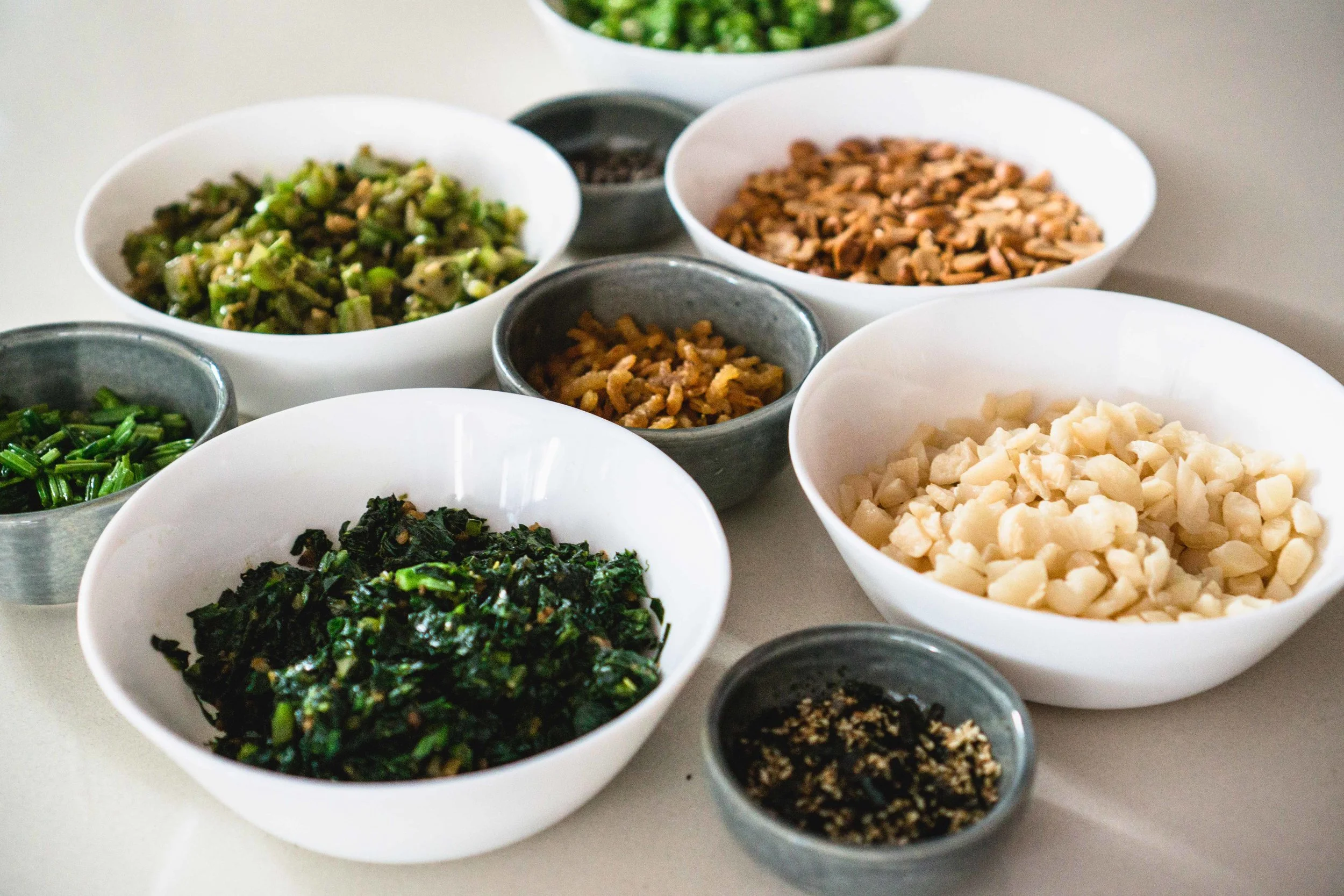Leicha-zuke (Chinese Tea Soup, Made Japanese)
Here’s a question—when it comes to food, what does authenticity really mean? I’ve talked about this topic on many fronts with food friends, and despite the deluge of discussions, I haven’t found a satisfactory answer. Yet.
See, when it comes to uncovering the origins of dishes, there are often endless spools of threads tangled so tightly they are almost impossible to unravel. Take the simple red bean soup for instance. In Asia, it’s often regarded as a Chinese dessert, a classic Cantonese tong sui. But turn to the opposite side of the world, and you’ll find in the Dominican Republic a strikingly similar dish called habichuela con dulce. Sure, the Dominican version is served with sweet potatoes and milk biscuits, but the base itself—bean soup—is made the exact same way. So can we really consider red bean soup as truly, authentically Chinese?
Even dishes that we think are inherently nationalistic have dubious origins. Take Malaysia’s classic kopitiam fare (the likes of which Singapore will certainly try turning into a national heritage)—roti bakar, overly runny eggs, and a cup of kopi. It’s really somewhat of a borrowed breakfast, because it seems suspiciously similar to the English morning staple of butter and jam on toast, soft-boiled eggs, and a cup of coffee, no?
Still not convinced? Consider Malaysia’s national dish—nasi lemak. The most barebones version of nasi lemak contains rice, sambal, roasted peanuts, and fresh slices of cucumber. (Fried anchovies and a hard-boiled egg split in half, while ideal, isn’t always a given.) Out of these four core components, two of them aren’t actually indigenous to Malaysia. Peanuts came by trade vessels from Latin America, and rice cultivation spread from China millennia ago. So really, how authentic is our national dish when half of it wouldn’t be possible without some sort of influence from other cultures? When our food itself is a blurry mishmash of other cultures, it’s hard to separate what is borrowed, and what truly came from the pure ingenuity of (wo)men.
If you’ve read and tried a few recipes from this blog, you’ll realise that authentic or not, it’s really this spirit of culture fluidity which I love drawing inspiration from. The way I see it, it’s not so much a question of authenticity as it is about the appreciation of the many cultural threads that make up each dish.
This week’s recipe is no different. It’s a combination of two soupy rice dishes, originating from two countries that have historically butted heads with each other on many issues.
The first—leicha. It is a Hakka Chinese dish of rice, condiments (mostly bits of stir-fried vegetables and roasted nuts and grains), and most crucially, a green soup made of basil, tea leaves, herbs and nuts blended together. To eat it, you pour the soup over the rice and condiments, and mix everything together into a gloopy green gruel that tastes a whole lot better than you’d think.
(Fun fact: Leicha is often mis-translated to ‘thunder tea’. But as much as I want it to sounds like something Chun Li would eat, the ‘lei’ here does not mean thunder.)
The second—ochazuke, is a Japanese dish mostly made using leftover rice, and whatever other bits and pieces you can scavenge off your fridge (bits of flaked fish, pickled vegetables, anything vaguely Japanese, really). It’s then served altogether in a steamy soup made with a green tea or dashi base.
The recipe below is pretty much a classic lei cha, except for a few Japanese-y twangs. First, I fortified the leicha soup base with some matcha (green tea) powder and kombu stock to give it some extra sweetness from the tea and seaweed savouriness. As for the rice, I topped it with some furikake and salted kombu, which adds yet more nutty depth to the typical leicha.
It’s one of the tamer combinations I’ve made, and while it might not solve the Sino-Japanese conflict, maybe, just maybe, some conservative Chinese cook out there will realise the aromatic sweetness matcha brings when mixed into leicha, and love Japan a little bit more. And perhaps a Japanese hardhead out there will add some nuts and blended herbs into his weeknight ochazuke, bringing him that bit closer to Chinese culture.
Ah, what wishful thinking, eh?
Lei-chazuke
Serves 4-6
Ingredients
Tea base
1L water
2 pieces kombu
3 pieces dried mushrooms (shiitake or shimeji)
250ml boiling water
10g matcha powder
2 tablespoons vegetable oil
30g garlic, minced
5g ginger, or 2g ginger powder
80g thai basil
30g mint
30g coriander
30g Chinese (leaf) celery
80g roasted peanuts
20g white sesame seeds
Condiments
350g sushi rice (or jasmine rice), rinsed to remove excess starch
1 bunch (~120g) long beans, sliced thinly
3 stalks (~200g) kailan, leaves and stalks separated and chopped into small pieces
5 cloves garlic, minced
2 tablespoon oil
2 tablespoon soy sauce
1 tablespoon sesame oil
1 tablespoon Chinese rice wine
50g Chinese salted radish (chai poh), roughly minced
30g dried shrimp
100g roasted peanuts
1 tablespoon furikake
1 tablespoon salted kombu, optional
2 tablespoons kerisik (toasted coconut), optional
Directions
Tea base: Place the water, kombu, and dried mushrooms into a large pot, and bring it to a boil. Take it off the heat and place a lid on it. Let the kombu and mushrooms steep in it for at least 30 minutes, then remove the kombu and mushroom solids.
Meanwhile, bring the 250ml of water to a boil, and let it cool down for 1-2 minutes. Add in the matcha powder and whisk vigorously so the powder disperses through the water to make tea.
Pour the oil into a large pan, and place it over medium heat. Sauté the garlic and ginger in it until fragrant. Then add all the herbs to the pan (basil, mint, coriander, and Chinese celery), and saute until it all wilts. Transfer the sautéed greens into a blender, and add in the peanuts, sesame seeds, and the liquid matcha. Blend this until smooth. Pour the green liquid into the kombu stock, and bring to a boil. Take it off the heat and cover with a lid to keep warm.
Rice: Cook the rice in a rice cooker or pot until fluffy. (I prefer using a rice cooker, but if you’re using a pot, a 1:1 ratio of rice to water should do nicely, and cook it on medium-low heat for 20-30 minutes.)
Condiments: First, dry fry the salted radish and dried shrimps sepately in a wok or pan.
Once you’re done, start chopping and sautéing the vegetables. The vegetables should be cooked separately (so you end up with three separate condiments of long beans, kailan leaves, and kailan stems), but they go through the same cooking process—fry the garlic until fragrant, then add in the vegetables, and season with soy sauce, sesame oil, and rice wine. The kailan leaves take 1-2 minutes of stir frying, but the stems and the long beans take a little longer, around 3-5 minutes. When you’re done, place them in separate bowls.
Assembly: Place the rice in the middle of the bowl, and arrange the cooked vegetables and the rest of the condiments—salted radish, shrimps, peanuts, furikake, kombu, and kerisik—all around the rice. Serve it with the tea soup on the side, and when you’re ready to eat, pour the soup all over the rice and condiments and mix them all up!









